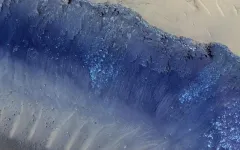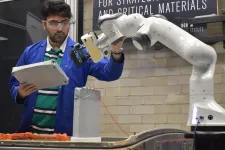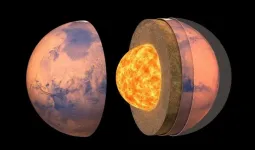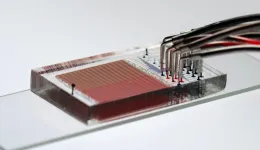NASA InSight Lander's seismic observations reveal the interior of mars
2021-07-22
(Press-News.org) NOTICE: This summary has been updated to correct misspellings of the last names of both Perspective authors. The Perspective authors are Sanne Cottaar and Paula Koelemeijer. We apologize for our error.
The first direct seismic observations from NASA's InSight lander, presented in three studies in this issue, provide clues to the composition of Mars. Researchers across these studies report preliminary findings from the Insight mission and begin to map - for the first time - the interior of a planet apart from Earth. "These three studies provide important constraints on the present-day structure of Mars and are also key for improving our understanding of how the planet formed billions of years ago and evolved through time," write Sanne Cottaar and Paula Koelemeijer in a related Perspective. Studying a planet's interior layers - its crust, mantle and core - can reveal key insights into its formation and evolution, as well as uncovering any geomagnetic and tectonic activity it hosts. Such deep interior regions can be probed by measuring the waves that travel through the planet's body following seismic events like a quake. Such methods have been instrumental in surveying the internal characteristics of Earth.
In early 2019, NASA's Martian lander InSight (Interior Exploration using Seismic Investigations, Geodesy and Heat Transport) began to detect and record marsquakes from its position on the surface of Mars, including several subcrustal quakes that resemble tectonic events on Earth. Brigitte Knapmeyer-Endrun and colleagues used marsquakes and ambient seismic noise to image the structure of the Martian crust below the InSight landing site, finding evidence for a multi-layered crust with either two or three interfaces. Extrapolating this data to the entire planet, Knapmeyer-Endrun et al. show how the average thickness of Mars' crust lies between 24 and 72 kilometers (km). Amir Khan et al. used direct and surface reflected seismic waves from eight low-frequency marsquakes to probe deeper and reveal the structure of Mars' mantle to a depth of nearly 800 km. Their findings suggest that a thick lithosphere lies close to 500 km below the surface and, like the Earth, likely has a low-velocity layer beneath it. According to Khan et al., Mars' crustal layer is likely highly enriched in heat-producing radioactive elements, which heats this region at the expense of the planet's interior. Deeper still, Simon Stähler and colleagues used the faint seismic signals reflected off the Martian core-mantle boundary to investigate the Martian core. They found that Mars' relatively large liquid metal core has a radius of nearly 1,830 kilometers and begins roughly halfway between the surface and the center of the planet, suggesting that the planet's mantle consists of only one rocky layer, rather than two, like in Earth. According to Stähler et al., the findings indicate that the iron-nickel core is less dense than previously thought and enriched in lighter elements. "Direct seismic observations on Mars represent a major leap forward in planetary seismology," write Cottaar and Koelemeijer. "Over the coming years, as more marsquakes are measured, scientists will refine these models of the red planet and reveal more of Mars' enigmatic mysteries."
ELSE PRESS RELEASES FROM THIS DATE:
Trash-bin foragers: Innovation and spread of complex culture in suburban parrots
2021-07-22
In the suburbs of Sydney, Australia, sulphur-crested cockatoos routinely loot lidded household waste bins to scavenge for food. In a new study, researchers document the emergence and geographic spread of innovative bin-opening behaviors in urban parrot populations, revealing the presence of a complex social learning culture in these birds. What's more, this behavior appears to have emerged as a direct response to land-use change and urbanization, demonstrating how animal cultures could allow for local adaptation of urban animal populations in the Anthropocene. In animals, ecological novelty, including novelties unique ...
A case for intranasal COVID-19 vaccinations
2021-07-22
Of the nearly 100 SARS-CoV-2 vaccines currently undergoing clinical trials, only seven are delivered intranasally - despite this vaccine type's long success in providing protection from influenza. In a Perspective, Frances Lund and Troy Randall argue that intranasal vaccines could be beneficial in the continued fight against COVID-19, especially considering respiratory viruses like SARS-CoV-2 predominantly enter the nasal passage first. Currently authorized COVID-19 vaccines are delivered via intramuscular injection, where they elicit systemic immune responses and central immune memory. While several ...
Spontaneous retinal waves simulate optical flow before neonatal mice can see
2021-07-22
Like dreaming of walking through a world they've not yet experienced, the retinas of neonatal mice practice for what mature eyes must later process by generating spontaneous patterns of activity that mimic the perception of directional movement through space, according to a new study. Essential functions in the mammalian visual system, including the ability to locate objects and detect motion, are present even at the first onset of vision. Optic flow, the perceived relative motion of objects and surfaces that seemingly stream by a field of vision during movement, is one of these functions. However, how the visual system organizes its functional characteristics before visual sensory experience is even possible remains unclear. ...
Mars: Scientists determine crustal thickness
2021-07-22
Based on the analysis of marsquakes recorded by NASA's InSight mission, the structure of Mars's crust has now been determined in absolute numbers for the first time. Beneath the InSight landing site, the crust is either approximately 20 or 39 kilometres thick. That is the result of an international research team led by geophysicist Dr Brigitte Knapmeyer-Endrun at the University of Cologne's Institute of Geology and Mineralogy and Dr Mark Panning at Jet Propulsion Laboratory, California Institute of Technology (Caltech). InSight stands for 'Interior Exploration using Seismic Investigations, Geodesy and Heat Transport'. NASA's lander, which ...
Global approach is needed on battery regulation
2021-07-22
New European Union regulations on batteries could offer a huge boost to the global decarbonisation mission - but only if it leverages its political and economic weight to ensure a fairer global marketplace.
According to a team of scientists and researchers writing in Science, the new regulations, due to come into force from January 2022, have the potential to unify policy on approaches such as recycling, use of recycled raw materials, and creating a circular economy.
Contributing to the study were experts at Newcastle University, the University of Birmingham, Circular Energy Storage Research and Consulting, ...
Eyes wide shut: How newborn mammals dream the world they're entering
2021-07-22
As a newborn mammal opens its eyes for the first time, it can already make visual sense of the world around it. But how does this happen before they have experienced sight?
A new Yale study suggests that, in a sense, mammals dream about the world they are about to experience before they are even born.
Writing in the July 23 issue of Science, a team led by Michael Crair, the William Ziegler III Professor of Neuroscience and professor of ophthalmology and visual science, describes waves of activity that emanate from the neonatal retina in mice before their eyes ever open.
This activity disappears soon after birth and is replaced by a more mature network of neural transmissions ...
InSight mission: Mars unveiled
2021-07-22
Using information obtained from around a dozen earthquakes detected on Mars by the Very Broad Band SEIS seismometer, developed in France, the international team of NASA's InSight mission has unveiled the internal structure of Mars. The three papers published on July 23, 2021 in the journal Science, involving numerous co-authors from French institutions and laboratories, including the CNRS, the Institut de Physique du Globe de Paris, and Université de Paris, and supported in particular by the French space agency CNES and the French National Research Agency ANR, provide, for the first time, an estimate of the size of the planet's core, the thickness of its crust and the structure of its mantle, based on the analysis of seismic waves reflected ...
Stanford researchers develop tool to drastically speed up the study of enzymes
2021-07-22
For much of human history, animals and plants were perceived to follow a different set of rules than the rest of the universe. In the 18th and 19th centuries, this culminated in a belief that living organisms were infused by a non-physical energy or "life force" that allowed them to perform remarkable transformations that couldn't be explained by conventional chemistry or physics alone.
Scientists now understand that these transformations are powered by enzymes - protein molecules comprised of chains of amino acids that act to speed up, or catalyze, ...
Alpha variant spread via 'super-seeding' event in UK: Oxford research
2021-07-22
The rapid spread of the Alpha variant of COVID-19 resulted from biological changes in the virus and was enhanced by large numbers of infected people 'exporting' the variant to multiple parts of the UK, in what the researchers call a 'super-seeding' event.
Results of the largest phylogeographic analysis ever conducted, published today in the journal Science, maps the spread of the variant (also known as lineage B.1.1.7) from its origins in Kent and Greater London in November 2020 to all but five counties in Wales, Scotland, Northern Ireland and England by 19 January.
Dr ...
Soft skin patch could provide early warning for strokes, heart attacks
2021-07-22
Engineers at the University of California San Diego developed a soft and stretchy ultrasound patch that can be worn on the skin to monitor blood flow through major arteries and veins deep inside a person's body.
Knowing how fast and how much blood flows through a patient's blood vessels is important because it can help clinicians diagnose various cardiovascular conditions, including blood clots; heart valve problems; poor circulation in the limbs; or blockages in the arteries that could lead to strokes or heart attacks.
The new ultrasound patch developed at UC San Diego can continuously monitor ...




